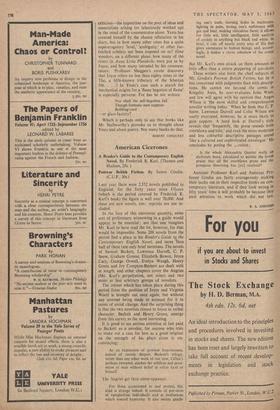Celtic Highlight
Between the Lines: W. B. Yeats's Poetry in the Making. By Jon Stallworthy. 38s.)
AMID today's vast overproduction of works about and around literature, it is always a relief to find the ones which are unmistakably connected with what writers actually do, not just what some unsubstantiated but strongly-held theory would have us suppose that they are, or might easily be, or ought to be doing. Mr. Stallworthy, by follow- ing the development of a number of Yeats's poems through their various stages of manu- script draft, would teach anyone more about poetry than could be learnt from three years' solid application in the average Department of English. The most obvious, and most commonly neglected, point would, be the old one that often the poet does not know what he is saying, or even the form in which he will say it, until he has got well started. The idea that a poet always has a definite feeling or emotion and that this is then 'expressed' 'or 'communicated' is one of many that must give way when actual MSS are examined (there is one such of a well-regarded modern poet, which starts off as a sad poem, and is converted to a gay one, halfway through the work, by the substitution of a different—in fact an opposite—set of adjectives).
This is no more than to say that the writing of poetry is a far more complex act than any literary theory would have us believe, and that most attempts to be 'rigorous' about- it—in this or any other aspect—are the irrelevant over- simplifications of the childishly tidy mind. Yeats's MSS do not teach the same lesson in quite so extreme a form, and in fact their main interest is the progress, almost invariably, from dull and obvious symbolism, or unmemorable lines, to 'a finer, more effective, and more inevitable-sounding art. For his verse depends as much (or rather more) on the brilliance of his conscious choice from the material that came to him as on the unknown processes which pro- duced the phrases and ideas. (If I say that this procaos worked 'almost invariably,' it is because, for example, lines 10-17 of 'The Second Coming,' with the too-clearly-realised sphinx-figure, seem to exemplify the occasional lapse.) In Yeats we do not find changes of tone quite as extreme as the sad-gay shift made right through a poem. But it is interesting that 'Breathless mouths may summon' in 'Byzantium' was through most of the drafts 'Breathing mouths may summon.' And, according to Professor Curtis Bradford (Publications of the Modern Language Association of America, Vol. 75, 1960), `Those images that yet/ Fresh images beget' had earlier been `.. . that yet/ Worse images beget,' a very interesting change of tone. Mr. Stallworthy here gives us . . that yet/ More images beget.' But, as he disarmingly says in his preface, there are many difficult readings, and 'Science, I am afraid, will lay bare many sins of omission and commission in my transcriptions.' There is one reading in the very first draft of the same poem where Bradford's (`The last benighted robber or assassin fled') must be better than Stallworthy's impossible 'The last benighted robber or army fled'; but the mere possibility of such a confusion shows what the MS present's in the way of ille- gibilities (it looks like 'army,' but then 'fled' looks like 'plan).
Even so, there are remarkably few substantial divergencies between the transcripts. And Mr. Stallworthy's book, with its modest and judicious commentary, is very welcome. The poems dealt with are: 'The Second Coming,' A Prayer for my Daughter; `The Sorrow of Love' (a special case, of course, on account of the extensive re- writing done on it a generation after its first appearance, on which Louis MacNeice has given us such penetrating and commonsensical com- ment), 'The Gift of Harun Al-Rashid,' In Memory of Eva Gore-Booth and Con Markie- wicz,"Coole Park 1929,"The Black Tower,' A Bronze Head,' nine shorter pieces, and the two Byzantium poems. A revealing selection, and as to the last, one is glad to see quoted Yeats's re- mark about the much-discussed 'flames' as being `flames at the street corners.' Attempts to make them reflect 'at one level' the glinting of the mosaics inside Santa Sophia shows one of the things which are wrong with our present-day criticism—the imposition on the poet of ideas and associations arising (or laboriously worked up) in the mind of the commentator-alone. Yeats has covered himself by the chance refutation in his diary, but in how many other cases has a quite supererogatory `level,' ambiguity,' or other far- fetched subtlety not been imposed on us? (One wonders, on a different plane, how many of the rivers in Anna Livia Plurabelle were put in by Joyce, and how many intruded by his commen- tators: 'Professor Shagpen's recent discovery that Joyce refers no less than eighty times to the The, a little-known tributary of the Siberian Ob. . .") In Yeats's case such a search for mechanical origins for a 'flame begotten of flame' is especially perverse. For has he not written
Nor shall the self-begotten fail Though fantastic men suppose Building-yard —or glass-factory?
Which is perhaps only to say that books like Mr. Stallworthy's provoke us to thought about Yeats and about poetry. Not many books do that.
ROBERT CONQUEST







































 Previous page
Previous page